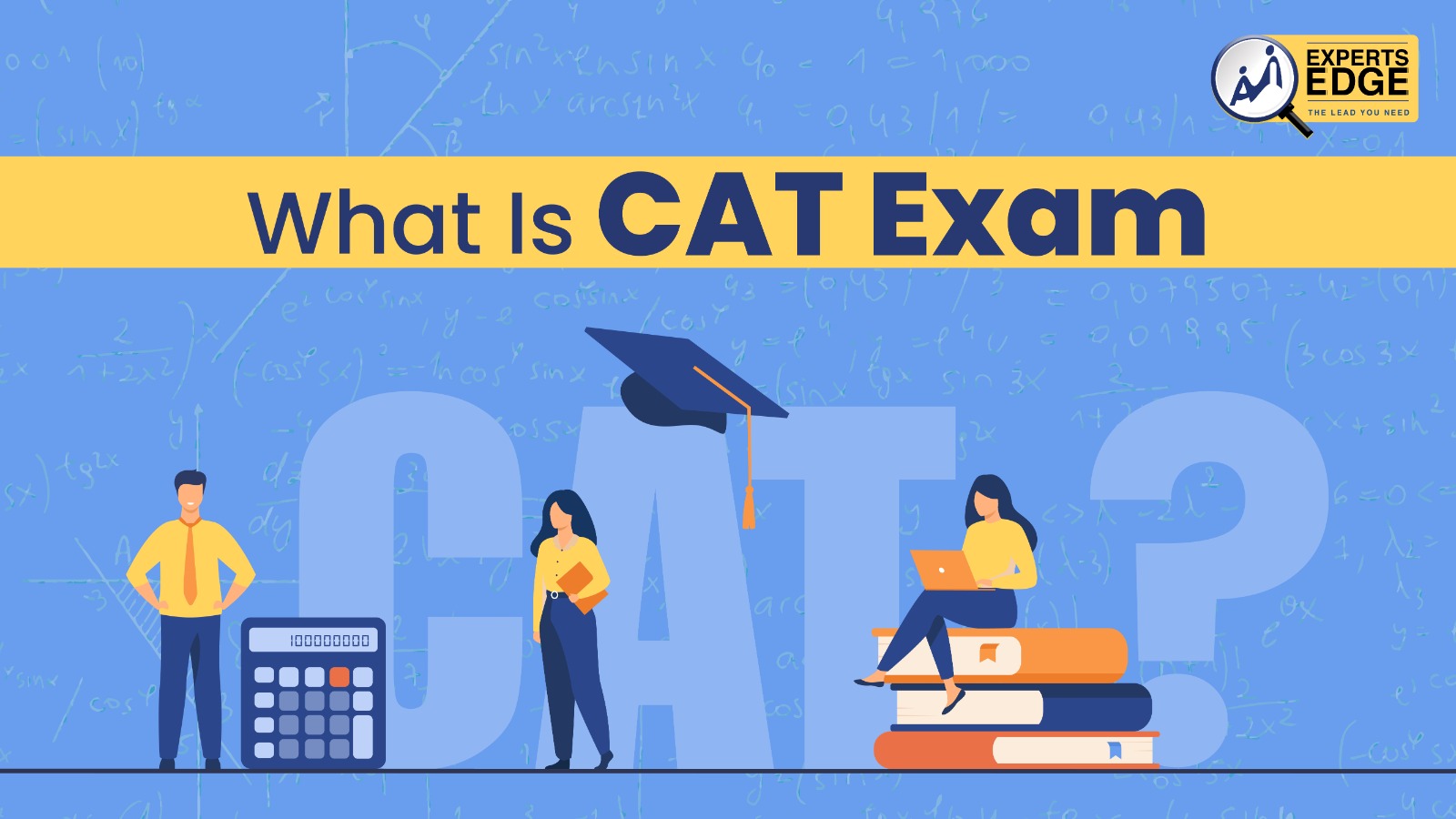The Indian Institutes of Management (IIM) opened their gates to a common management based admission test known as CAT in 1950. Since then, hundreds of thousands of students take such tests each year to apply for prestigious business schools across the globe.
In this blog, we will understand what is CAT exam, the CAT exam syllabus and pattern of the exam and the important dates and deadlines for the exam. So keep reading to get detailed understanding about the CAT exam:

What is a CAT Exam?
The Common Admission Test (CAT) ranks among the highly competitive and popular entrance tests for students to consider, especially those keen to join prestigious institutes of management in India such as the IIMs and other top B schools in the country.
Many individuals appear for this exam every year in a bid to join such institutions. The CAT exam pattern is quite a fleet that offers an understanding of the nature of questions and areas that require concentration while preparing.
In addition to all that, due to the fact that the CAT exam format and syllabus remain the same from year to year, this means it is also imperative to grasp other relevant information to the exam for one to be fully prepared.
Get the first AiExpertEdge CAT Online Course with 20% Discount
Highlights of the CAT Exam
| Particulars | Details |
| Full Form of CAT Exam | Common Admission Test (CAT) |
| Conducting Body | Indian Institutes of Management (IIM) |
| Exam Level | National |
| Frequency | Once a year |
| CAT Exam Date 2024 | Sunday, November 24, 2024 |
| Exam Mode | Online Computer-Based Test (CBT) |
| Number of Test Cities | 170 cities |
| Exam Timings | Conducted in 3 slots |
| Eligibility Criteria | Graduation with 50% aggregate (45% for SC/ST/PwD candidates) |
| Number of Applications (2023) | 3.33 lakh |
| Purpose | Admission to IIMs and over 1,200 B-Schools |
| Degrees Offered | MBA/PGDM |
Importance of CAT Exam:
Those who wish to do an MBA, more so from institutes like the IIMs, for those appearing in CAT and scoring well in CAT exam is crucial as it enhances the chances of being admitted in any of the prestigious IIM or any other prestigious B-school, which is renowned for its quality education, global placement and vast network of former students turned professionals.
Purpose of the CAT Exam
The CAT exam is a uniformly administered qualifying test aimed at ensuring applicants’ preparedness for the demands of an MBA program. It tests important business skills such as quantitative ability, verbal ability, data sufficiency and logical thinking of the student. As the structure of CAT presents a common standard across various levels of education, it avoids bias in testing the educational competence of the individual candidates. In this way, CAT focuses on measuring one’s intellect as well as management capabilities in a person to pick those who will best fit into the tough world of business and management.
CAT Exam Pattern
There has been no significant alteration in the CAT exam pattern as compared to the last year. It mainly comprises of three sections i.e. VARC, DILR and QA:
| Section Name | Number of Questions | Allotted Time (in Minutes) |
| Verbal Ability and Reading Comprehension (VARC) | 24 | 40 |
| Data Interpretation and Logical Reasoning (DILR) | 20 | 40 |
| Quantitative Aptitude (QA) | 22 | 40 |
| Total | 66 | 120 |
The duration of the CAT exam is 2 hours and the exam is divided into three sections. Each segment has been allocated 40 minutes. Thus, candidates cannot shift to the other segment after the time duration of that particular segment has elapsed.
CAT Exam Marking Scheme
- Correct Answer: +3 marks
- Wrong Answer (MCQ): -1 mark
- Wrong Answer (Non-MCQ):No negative marking
- Unanswered Question: No negative marking
Note: Type-In-The-Answer questions or Non-MCQs questions carry no negative marking
CAT Exam Syllabus Detailed Breakup
The CAT exam syllabus is divided into three major sections each with a different set of topics. Let’s break up all three of them in detail and understand.
Verbal Ability and Reading Comprehension (VARC)
This section tests your ability with the English language, reading comprehension skill combined with verbal reasoning is put to test. It is considered as one of the crucial sections. Some key topics from reading comprehension include types of passages that appear in the section: Business, Economics, Sociology, History, Science and Literature.
Key topics from Verbal Ability majorly includes Sentence Correction, Para jumbles (ordering paragraphs logically, Para summary (choosing the best summary for a paragraph), Fill in the blanks and Odd sentence out from a jumbled set type of questions which forms a significant part of what is CAT Exam.
Data Interpretation and Logical Reasoning (DILR)
This section tests your ability as a candidate for being able to interpret data from more than one source and then use that logic to tackle problems. This is one of the most challenging sections of the test, as it demands both speed and accuracy.
The Important Topics from the Data Interpretation (DI) section includes Tables, Pie Charts, Bar Graphs, Line Charts, Caselets, Venn Diagrams, Data Sufficiency and the key topics from Logical Reasoning (LR) section includes, Seating Arrangements, Linear and Circular, Blood Relations, Syllogisms, Clocks and Calendars, Puzzles and Series and Sequences practising this section thoroughly is vital for doing well in what is CAT exam.
Quantitative Aptitude (QA)
This section is designed to test the mathematical ability of the student. Skill development in the realm of problem-solving is kept under the spotlight. This section consists of problems related to a wide variety of mathematical domains.
Some of the Important Topics of QA includes in Number System the Divisibility rules, HCF and LCM, Prime numbers, in Arithmetic the Percentages, Profit and Loss, Time and Work, Time-Speed-Distance, Ratio and Proportion, Simple and Compound Interest in Algebra the Linear and Quadratic Equations, Inequalities, Logarithms in Geometry and Mensuration the Circles, Triangles, Polygons, Coordinate Geometry in Modern Mathematics the Probability, Permutations, Combinations, Set Theory, Functions etc is essential to succeed in what is CAT exam.
Section-Wise Preparation Tips
- Verbal Ability and Reading Comprehension: To do well in this section make sure you read and improve your comprehension ability by practising enough. Make sure to analyse the tone of the author and logically draw inferences from the passages to excel in what is CAT exam.
- Data Interpretation and Logical Reasoning: This section demands a logical and structured approach to solve the question. Keep practising set types of questions to deal with the complicated questions easily.
- Quantitative Aptitude: If you want to do well in this section you have to focus on improving the speed in calculation and should have a strong hold on the mathematical concepts. Expectedly, time again plays a vital role here and is crucial for scoring well in what is CAT exam.
CAT Exam difficulty level and competitiveness
- Understanding the difficulty level: The Common Admission Test (CAT) is well known for its difficult and tricky questions in the sections of DILR and QA. The examination not only the theoretical knowledge but also one’s ability to solve the questions very fast and accurately under pressure
- Comparison with Other MBA Entrance Exams: The Common Admission Test (CAT) brings something new perspective of reasoning ability under pressure within the sections, which is quite unlike XAT, GMAT, NMAT, or other such examinations. While for some elements of exams timing may be more relaxed, CAT makes it more difficult.
- Competitiveness: There are about 200,000 students seeking admission to a few seats in top B-schools, making CAT even more difficult. In order to reach the high percentile, the candidates need to prepare well as most of the IIMs call only those candidates who score above 90 percentile.
Also learn – CAT Exam Syllabus
Conclusion
Preparing for the CAT exam entails a comprehensive system, which consists of; A thorough understanding of the syllabus, praying and practice, adequate and effective ways of managing time. Having a clear layout for all the sections of the paper i.e.Verbal Ability and Reading Comprehension, Data Interpretation and Logical Reasoning and Quantitative Aptitude, will help you to perform better meaning there is a higher probability of getting admission in the management course you cherish.
With the aid of good quality material, mock tests, and continued practice, you can face the CAT exam with confidence and fulfil your dreams of studying management and building the careers towards management that you have always wanted.
All the best for your preparation





